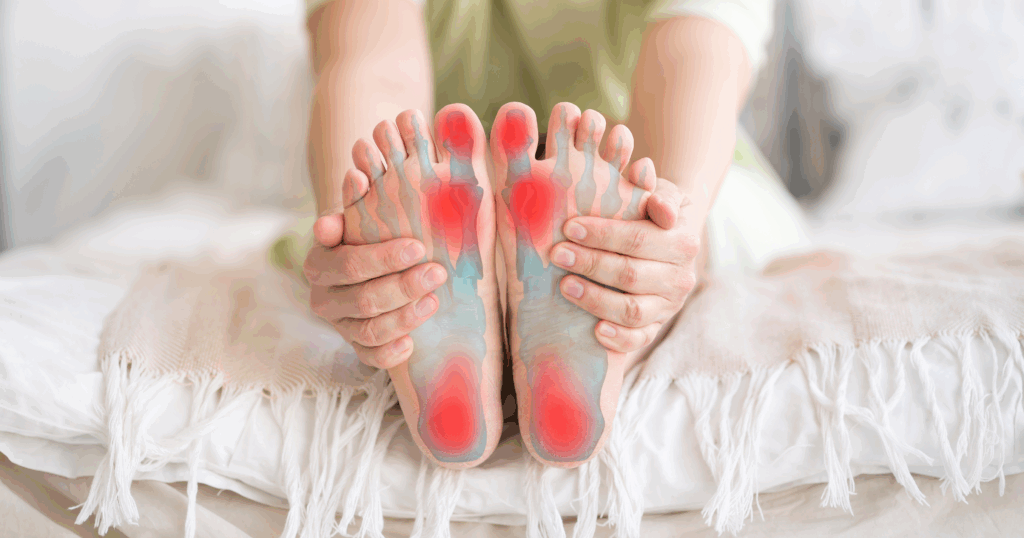Reflexology for Plantar Fasciitis: A Holistic Approach to Lasting Relief
Plantar fasciitis is far more than a simple ache in the heel—it’s a persistent challenge that can affect every step you take, disrupting your daily life and diminishing your overall vitality. The discomfort often starts subtly but can quickly escalate, making walking, standing, or even resting a painful ordeal. While conventional treatments offer some relief, many seek a more natural, integrative approach that addresses both the symptoms and the underlying imbalances contributing to this condition.
Reflexology, an ancient healing art rooted in Traditional Chinese Medicine, provides a compassionate and effective pathway to soothe plantar fasciitis. By stimulating specific reflex points on the feet, reflexology not only targets localized pain but also supports the body’s innate ability to heal and restore harmony. This approach invites a deeper connection with the body’s own rhythms and healing capacities, offering relief that goes beyond symptom management to foster genuine restoration of foot health and overall well-being.
Reflexology for Plantar Fasciitis: A Holistic Approach to Lasting Relief
Plantar fasciitis is far more than a simple ache in the heel—it’s a persistent challenge that can affect every step you take, disrupting your daily life and diminishing your overall vitality. The discomfort often starts subtly but can quickly escalate, making walking, standing, or even resting a painful ordeal. While conventional treatments offer some relief, many seek a more natural, integrative approach that addresses both the symptoms and the underlying imbalances contributing to this condition.
Reflexology, an ancient healing art rooted in Traditional Chinese Medicine, provides a compassionate and effective pathway to soothe plantar fasciitis. By stimulating specific reflex points on the feet, reflexology not only targets localized pain but also supports the body’s innate ability to heal and restore harmony. This approach invites a deeper connection with the body’s own rhythms and healing capacities, offering relief that goes beyond symptom management to foster genuine restoration of foot health and overall well-being.
Key Takeaways
-
Reflexology targets specific foot zones related to the plantar fascia, helping release tension and reduce heel pain at its root.
-
Applying pressure through reflexology improves circulation, which supports faster healing of inflamed tissues in the feet.
-
Consistent reflexology sessions enhance flexibility in the plantar fascia, decreasing the risk of future injury or chronic discomfort.
-
Reflexology is a natural therapy reduces inflammation and supports lymphatic drainage, providing relief without relying solely on medications.
-
Integrating reflexology into your wellness routine complements traditional treatments and promotes long-term foot health and function.
Understanding Plantar Fasciitis
What is Plantar Fasciitis?
The plantar fascia is a thick, fibrous band of tissue that stretches from your heel bone to the base of your toes, supporting the arch of your foot and acting as a natural shock absorber. When this tissue becomes inflamed or strained, it results in plantar fasciitis—a condition characterized by sharp, stabbing heel pain, especially noticeable with your first steps in the morning or after prolonged rest. Several factors contribute to the development of plantar fasciitis. Excessive pressure or repetitive strain on the plantar fascia can cause tiny tears, leading to inflammation and pain.
Common risk factors include:
- Obesity: Extra weight increases stress on the plantar fascia.
- Age: People between 40 and 60 are more prone to this condition.
- Activity Level: High-impact sports like running or prolonged standing.
- Foot Structure: Flat feet, high arches, or abnormal gait patterns.
- Occupation: Jobs requiring long hours on your feet.
Symptoms often include stiffness, burning sensations, and tenderness in the heel, which can interfere with daily activities and reduce quality of life.
Conventional Treatments and Their Limitations
Traditional approaches to plantar fasciitis often start with rest, ice application, and over-the-counter anti-inflammatory medications (NSAIDs). Orthotics and physical therapy aim to support the foot’s structure and improve flexibility. In more persistent cases, corticosteroid injections or even surgery might be recommended.
While these treatments can be effective, they sometimes fall short in addressing the root causes or providing lasting relief. Many patients find themselves caught in a cycle of temporary fixes, frustrated by recurring pain or side effects from medications. This is where alternative therapies like reflexology can complement conventional care, offering a holistic path to healing.
Reflexology: An Overview
What is Reflexology?
Reflexology is a therapeutic practice dating back thousands of years, with roots in ancient Chinese and Egyptian medicine. It operates on the principle that specific points on the feet, hands, and ears correspond to different organs and systems in the body. By applying targeted pressure to these reflex points, reflexologists aim to stimulate the body’s natural healing processes, improve circulation, and restore energetic balance.
A typical reflexology session involves gentle thumb and finger techniques, such as thumb walking and kneading, applied to precise zones on the feet. These zones reflect the entire body’s anatomy, allowing reflexologists to address not only localized pain but also systemic imbalances that may contribute to plantar fasciitis.
Reflexology vs. Massage Therapy vs. Acupressure
Though reflexology, massage therapy, and acupressure all involve manual manipulation of soft tissues, they differ in focus and technique:
- Reflexology targets reflex points on the feet (and sometimes hands and ears) linked to internal organs and body systems.
- Massage therapy generally involves broader manipulation of muscles and connective tissues to relieve tension and improve circulation.
- Acupressure applies pressure to specific acupuncture points along meridians to unblock energy flow.
For plantar fasciitis, reflexology uniquely combines localized foot treatment with systemic benefits, making it a compelling choice when seeking natural pain relief and healing support.
How Reflexology Can Help Plantar Fasciitis
Mechanisms of Action
Reflexology’s effectiveness in plantar fasciitis lies in its ability to influence several key physiological and energetic pathways:
Targeting Reflex Points Related to the Plantar Fascia
Reflexologists focus on the heel and arch areas of the foot, where the plantar fascia is located, applying precise pressure to these zones. This targeted stimulation helps to release tension in the fascia and associated muscles, encouraging tissue repair and flexibility. Regular treatment can alleviate tightness and improve overall foot function by addressing these key reflex points.
Reducing Inflammation and Pain
Applying firm yet gentle pressure during reflexology helps break up adhesions and reduces inflammatory mediators in the plantar fascia. This action promotes relaxation of the affected tissues and can ease the sharp heel pain characteristic of plantar fasciitis. Additionally, reflexology encourages lymphatic drainage, which assists in reducing swelling and accelerating recovery.
Improving Circulation
Enhanced blood flow is a crucial benefit of reflexology, as it delivers oxygen and vital nutrients to damaged tissues while facilitating the removal of metabolic waste. Improved circulation supports faster healing of the plantar fascia and surrounding structures. This increased vascular activity also helps reduce stiffness and promotes tissue flexibility, essential for restoring foot mobility.
Increasing Tissue Flexibility
Reflexology encourages lateral deviation and gentle stretching of the plantar fascia and adjacent muscles, enhancing their elasticity. This increased flexibility helps prevent further microtears and reduces the risk of chronic pain. Over time, improved tissue pliability contributes to better shock absorption and foot mechanics during walking and standing
These combined effects not only alleviate pain but also support the foot’s natural healing process, reducing the likelihood of chronic discomfort.
Scientific Evidence and Research
While reflexology is often categorized as a complementary therapy, emerging studies are beginning to validate its benefits for plantar fasciitis. Clinical trials have demonstrated that reflexology can significantly reduce heel pain and improve foot function when used alongside conventional treatments.
Experts in integrative medicine recognize reflexology’s role in modulating the nervous system and promoting parasympathetic activation, which helps the body enter a state of rest and repair. Testimonials from patients frequently highlight immediate relief following sessions, though sustained improvement usually requires multiple treatments. That said, reflexology is not a standalone cure. Its greatest strength lies in being part of a comprehensive, patient-centered approach to foot health.
Reflexology Techniques for Plantar Fasciitis Relief
Professional Reflexology: What to Expect
A professional reflexology session for plantar fasciitis typically begins with a thorough assessment of your foot’s condition and overall health. Our reflexologist will gently move and stretch your feet to evaluate mobility and identify areas of tension.
Key techniques include:
- Thumb Walking: Applying rhythmic pressure along the plantar fascia and heel.
- Pressure Point Stimulation: Targeting specific reflex points related to the foot, lower leg, and even spine.
- Stretching and Mobilization: Encouraging flexibility in the foot’s soft tissues.
Sessions usually last between 30 to 60 minutes, with a recommended frequency of one to two times per week initially. Reflexology is safe for most individuals, but those with circulatory issues, infections, or open wounds should consult their healthcare provider first.
At-Home Reflexology: Step-by-Step Guide
Empowering you to take control of your healing, here are simple reflexology techniques you can perform at home:
- Warm-Up: Soak your feet in warm water for 10 minutes to relax muscles.
- Movement: Gently flex, extend, and rotate your ankles to increase circulation.
- Pressure Application: Use your thumb to apply firm but comfortable pressure along the arch and heel, moving in small circles.
- Massage Tools: Incorporate massage balls or rollers to deepen the release of tension.
- Duration: Spend 5-10 minutes per foot daily, adjusting pressure to avoid discomfort.
Consistency is key. Combine these techniques with stretching exercises and proper footwear for best results. If pain worsens or persists, seek professional reflexology or medical advice.
Integrating Reflexology with Other Treatments
Reflexology works best when integrated into a holistic foot care routine. Consider combining it with:
- Stretching and Strengthening Exercises: Target the calf muscles and plantar fascia to improve flexibility and support.
- Orthotics and Supportive Footwear: Correct biomechanical imbalances and reduce strain.
- Complementary Therapies: Yoga enhances overall body alignment; acupuncture can address systemic inflammation; physical therapy focuses on functional rehabilitation.
Acupuncture, in particular, complements reflexology by promoting muscle relaxation, reducing inflammation, and enhancing blood flow to the affected area. This multifaceted approach helps alleviate plantar fasciitis pain more effectively than any single treatment alone.
By addressing plantar fasciitis from multiple angles, you create a sustainable path to recovery and long-term foot health.
Tips for Preventing Plantar Fasciitis Recurrence
Prevention is as important as treatment. To minimize the risk of plantar fasciitis returning:
- Choose shoes with good arch support and cushioning.
- Incorporate daily stretches for your calves and feet.
- Avoid prolonged standing or high-impact activities without proper conditioning.
- Maintain a healthy weight to reduce foot stress.
- Practice mindful movement and posture to prevent undue strain.
These lifestyle adjustments, combined with regular reflexology sessions, can keep your feet strong and pain-free.
Why Reflexology Should Be Part of Your Healing Journey
Plantar fasciitis can feel like an unrelenting burden, but relief is truly within reach. Reflexology offers a compassionate, natural, and effective way to reduce pain, restore function, and support your body’s innate healing abilities. By addressing both the localized discomfort in your feet and the systemic imbalances that contribute to chronic inflammation, reflexology provides a holistic approach that complements conventional treatments.
At ACA Acupuncture & Wellness, we are dedicated to guiding you through this healing journey with personalized care that honors both ancient wisdom and modern science. Our integrative approach ensures that your treatment plan is tailored to your unique needs, helping you regain mobility and improve your quality of life.
Source:
Juchli, L. (2021, June 1). Effectiveness of Massage Including Proximal Trigger Point Release for Plantar Fasciitis: a Case Report. https://pmc.ncbi.nlm.nih.gov/articles/PMC8133876/
Frequently Asked Questions
Can a reflexologist help with plantar fasciitis?
Yes, reflexologists can help by applying targeted pressure to specific points on the feet that correspond to the plantar fascia and related areas, which may reduce pain and improve flexibility. Reflexology also promotes relaxation and improved circulation, which can support the healing process. While it is best used as a complementary therapy, many patients report relief and enhanced foot function after reflexology treatments.
Where is the pressure point for plantar fasciitis?
The key pressure points for plantar fasciitis are located on the heel and the arch of the foot, where the plantar fascia connects and supports the foot’s structure. Reflexologists also focus on points linked to the lower leg and spine to address related muscular tension and promote overall balance. Stimulating these areas helps release tension and improve blood flow to the affected tissues.
Does rolling a ball under your foot help plantar fasciitis?
Yes, rolling a massage ball under the foot can help by gently stretching and loosening the plantar fascia and surrounding muscles. This self-massage technique increases circulation, reduces tightness, and can alleviate pain when done regularly and with appropriate pressure. It is a simple, effective at-home method often recommended alongside professional treatments.
How can I get permanent relief from plantar fasciitis?
Permanent relief usually requires a comprehensive approach that combines rest, proper footwear, stretching, strengthening exercises, and therapies like reflexology or physical therapy. Addressing biomechanical issues and lifestyle factors that contribute to plantar fascia strain is essential for long-term healing. Consistency and patience in following a holistic treatment plan are key to preventing recurrence.
Does foot reflexology really work?
Foot reflexology has been shown to provide pain relief, reduce inflammation, and improve circulation, which can benefit plantar fasciitis sufferers. Although scientific evidence is still limited and mixed, many patients experience subjective improvements in pain and mobility. Reflexology is best viewed as a complementary therapy that supports conventional treatments rather than a standalone cure.
Is it good to put pressure on plantar fasciitis?
Applying controlled pressure through reflexology or massage can be beneficial by releasing tension and promoting blood flow in the plantar fascia. However, excessive or improper pressure may worsen inflammation or pain, so techniques should be gentle and adapted to individual tolerance. Consulting a professional reflexologist or therapist ensures safe and effective pressure application.
Contact ACA Acupuncture & Wellness
Get in Touch
Newsletter Sign Up
LOCATIONS
MANHATTAN
QUEENS
NEW JERSEY
CALIFORNIA

ACA Franchise Opportunities
The over $4 billion US acupuncture market offers a great opportunity with over 10% annual growth rates and a continuing flow of new patients interested in the benefits of acupuncture.







